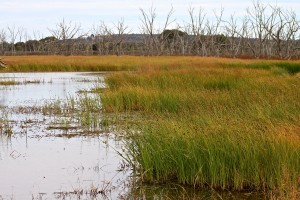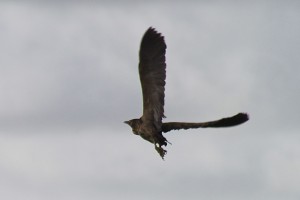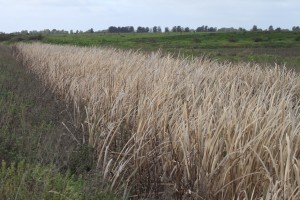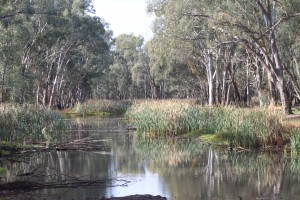Never mind the possibility of life beyond Earth, this is the real burning question! With such significant numbers of the globally endangered Australasian Bittern (Botaurus poiciloptilus) using Riverina rice fields, and now that we know there’s widespread breeding as well, it’s crucial that we work out which wetlands they depend on during the colder months of the year. Thanks to funding from the Riverina Local Land Services, The Bitterns in Rice Project has begun to solve this curious mystery.
This year, the rice harvest was late, delayed by wet weather, but by the end of May most of these temporary agricultural wetlands that bitterns had called home over summer had been drained or dried out. The headers had been and gone, taking with them the typical ten tonne per hectare harvest. So last week we began targeted surveys of key wetland areas in the Riverina with the aim of finding some of their non-breeding, post-harvest haunts.
We had little idea of what to expect. There was every chance they’d all headed to the coast and we’d just be trudging through cold Riverina swamps for the fun of it. Monitoring data from the Edithvale-Seaford Wetlands near Melbourne indicate relatively large numbers of bitterns arrive in autumn, coinciding with rice harvest. These bitterns remain present throughout winter and depart before summer. Perhaps these are some of the bitterns from the rice fields and they’re indicative of a broader coastward movement pattern.
In what was a great start, we found 11 bitterns across a range of different wetland types last week, the best sites being a Cumbungi-filled drainage channel near Coleambally (below left), with four birds, and Campbell’s Swamp near Griffith (above left), also with four birds. The well-known Fivebough Swamp near Leeton yielded two, while the Forest Creek near Conargo produced our first bittern for the week.
We need to find more birds at more sites when we conduct surveys in spring and then wait until summer to see if these bitterns are associated with the rice or not. The idea is simple. The numbers of bitterns we find at these sites outside of the rice-growing season should plummet as they move into the rice. While it’s no substitute for tracking individual birds, we should start to get a good idea of important non-breeding refuges in the Riverina and whether or not a large part of the population leaves. To complicate matters though, this no doubt varies from year to year, depending on the conditions, and the wet autumn we’ve had might mean more bitterns are staying put than they have been in recent years.
Because Campbell’s and Fivebough Swamp yield bittern records each summer, it’s possible the birds we encountered there are resident and have nothing to do with the rice. If the bitterns from the rice fields are not in key wetlands like these, then where are they? The Coleambally birds in the cumbungi-filled drainage channel highlight the possibility that they’ll stick around if they can and the role that rice farmers can play in providing habitat outside of the rice season. This is one of our key Bittern Friendly Rice Growing Tips.
A number of wetlands along the Murrumbidgee River floodplain, such as those around Yanco (above right), showed great promise, as did parts of the Yanco Creek. Interestingly, quite a few landholders pointed out that all of their Cumbungi died off when the drought-breaking floods came. We were surprised not to get any bitterns at Tuckerbil and we also still have high hopes for the Mirrool Creek near Barrenbox Swamp and other wetland areas like Lake Wyangan.
Clearly, there are still plenty of missing pieces to this jigsaw puzzle and it’s quite possible that large numbers of bitterns did depart the Riverina once the rice was harvested, but with any luck we’ll be a whole lot closer to the truth after the next two surveys later this year. Stay tuned. Special thanks to Nathan Smith, trusty assistant bittern botherer who did more than his fair share of navigating through dense reed beds.
And for anyone that’s interested, the Bitterns in Rice Project was featured on ABC Radio National last week when rice grower John Hand and I were interviewed for the Bush Telegraph program. You can listen to it here.






Good work Matt and co. I will place this on the Friends website.
Bad as trying ot find out where Regents go post breeding!!
Hi Matt,
Itis great to read and hear about your conservation work with the bitterns.You and your colleagues and the farmers are an inspiration to bird lovers like me.Congratulations and continue with the great work that you and your colleagues are doing with this iconic Australian bird.
[…] proportion of the rice-breeding bittern population stays in the region, as the birds we found in winter and spring were not there in summer when the rice season was back in full swing. They used dams, […]
[…] bitterns in rice head off to far-flung wetlands on the coast. Prior to any tracking, we undertook winter and spring surveys at wetlands most likely to support bitterns in the Murrumbidgee and Coleambally […]